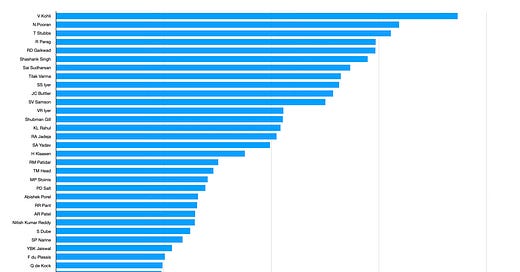In yesterday’s post, I wrote about the IPL Table of Justice for the 2025 season, and the development of some products which I will soon be bringing to market for cricket teams, the media and other organisations.
To register early interest in any of these, or to discuss further, please email sportsanalyticsadvantage@gmail.com.
The next area I want to look at is valuation of players. Again, I am using learned historical data to create independent and unbiased outputs, and with this analysis I want to show how this learned model valued current IPL batters, aligning them with established drivers of success.
While I can’t write in detail about how this was created - obviously it’s my own intellectual property and will have huge commercial value when completed - I will say that, as an example, if a player is highly valued by this model, it’s because their current performances align well with the performances of successful players in the past, and the drivers of success for successful teams.
This first step is simply assessing batter performance in the IPL, without financial valuations. That will be coming in the near future for any professional cricketer (taking in performances in numerous T20 leagues, weighted for opposition difficulty and conditions) for any league in the world, also factoring in the budgets teams have in each league.
For example - if you want to know the fair market price for Virat Kohli (simply based on playing performance, not marketing or other factors) for the IPL, this model will give an exact Crore price to several decimal points. It could, in theory, even work out a value for Virat Kohli (or any other player) if he was available to play in overseas T20 leagues such as The Hundred, the Big Bash or SA20, and take into account the different salary structure in those tournaments.
Moving on, here is an assessment of current IPL batters who faced 200+ balls from the start of the 2024 season onwards - if a player isn’t in this list, it’s because they didn’t face this sample size of balls in the assessed time period.
Some points in advance:-
The average IPL batter across all facets of a match will be valued at 100. However, in reality, a rating of 100 is very good because batters have different strengths and weaknesses, and are generally not as strong in some areas as others.
There will be examples of a player being lower rated here but able to contribute better than average in a certain role. For example, a death hitter is unlikely to be as highly rated as a number 3 or 4 because their role is generally constrained to one phase of their team’s innings, and they have less match involvement. Players who have a very specific role will be addressed further when I value players financially and allocate them roles in depth charts.
One player who looked out of line on the ratings was Ravindra Jadeja (15th of the 40 players assessed). I don’t think many people would think he’s the 15th best batter in the IPL (and some of the batters not included with smaller samples of data would also push him down further in the list) but there are caveats here which may apply to him and potentially, at times, other players too.
Because it’s an outlier which will raise talking points if I don’t explain further, my view is that Jadeja is batting in the wrong role for CSK. He actually aligns really well to batting in the middle order, providing elite non-boundary run production (only Stubbs was higher out of these 40 batters), and strong stability. Boundary-hitting and a strike rate ceiling are constrained, which makes his role as a number 6/7 in this CSK team quite strange - he’s not being used in a role where he can show his current strengths.
Evidently from the model production shown by the chart above, Virat Kohli was valued as the best IPL batter from the start of the 2024 season onwards by some distance, followed by Nicholas Pooran and Tristan Stubbs. The strength of domestic batters is well illustrated too, with seven of the top 10 batters in the model being Indian - only Pooran, Stubbs and Jos Buttler featured as overseas players in the top 10, although the likes of Heinrich Klaasen and Travis Head did make the top 20.
It should also be noted that the 11 players rated below 100 are still very good players. They could be excellent options in a specific role. Furthermore, given the strength of the IPL as a league, they’d almost certainly be above-average batters in other leagues worldwide.



